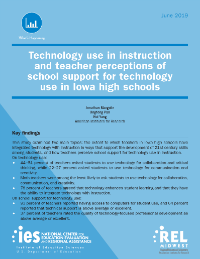-
About the RELs
+
-
For more than 50 years, the RELs have collaborated with school districts, state departments of education, and other education stakeholders to help them generate and use evidence and improve student outcomes. Read more
-
- Regions +
- Products
-
Topics
+
- Achievement Gap Career Readiness Charter Schools College Readiness COVID-19 Data Use Discipline Dropout Prevention
- Early Childhood Education English Language Learners Equity Literacy Mathematics Online Courses Postsecondary Education Principals
- Research Tools Rural Schools Social Emotional Learning Special Education Student Characteristics Teacher Effectiveness Teacher Persistence Teacher Recruitment
- Events
- Blog
- Connect with Us +
Home Products Technology Use in Instruction and Teacher Perceptions of School Support for Technology Use in Iowa High Schools
Technology Use in Instruction and Teacher Perceptions of School Support for Technology Use in Iowa High Schools

A growing national consensus shows the need for educational systems to prepare students to succeed in working environments and society of the 21st century. Recognizing this need, Iowa school districts have invested in technology to assist in addressing the expectations of the Iowa Core Standards related to 21st century skills. The rural districts served by the Central Rivers Area Education Agency (Central Rivers AEA) and three high schools formed the Iowa Learning and Technology Networked Improvement Community (Iowa NIC) to promote effective use of these technology resources. To inform these improvement efforts, the Iowa NIC requested that REL Midwest conduct a descriptive research study to describe the extent to which teachers are using technology to support the development of 21st century skills and describe teacher perceptions and school supports related to technology integration. The study team obtained teacher survey data and school data from Central Rivers AEA. The study examined proportion of teachers emphasizing each of the four 21st century skills (that is, collaboration, communication, creativity, and critical thinking). In addition, the study performed tests to determine which groups of teachers (for example, by subject area taught) differed in their responses for a given topic area. The proportions of teachers asking students to use technology to support the development of 21st century skills differed across the four skills, as well as across subject areas taught and teacher experience. Specifically, half or nearly half of the teachers emphasized the use of technology for collaboration or critical thinking at least monthly. By contrast, less than a fourth of the teachers emphasized the use of technology for communication or creativity at least monthly. Mathematics teachers were less likely than other teachers to ask students to engage in the use of technology for communication and creativity at least monthly. Teachers with 4-9 years of experience were most likely to ask students to engage in the use of technology in support of both collaboration and creativity skills at least monthly, and those with more than 20 years of experience were least likely. The study also found that most teachers believe they can integrate technology with instruction because educational technology has specific benefits for supporting student learning. Finally, most teachers have access to computers, the Internet, and adequate technical support, but access to professional development opportunities is limited. Teachers use classroom technology frequently, but they are not always consistent in using it to develop students' 21st century skills. This finding calls for additional support and encouragement to focus on those skills. Mathematics teachers may need additional professional learning opportunities that help them understand how technology can support specific curricular goals. Teachers with either 3 or fewer years of experience or 20 or more years of experience appear to be the most in need of additional training on using technology for instructional purposes.
Online Availability
ERIC Descriptors
21st Century Skills, Communication Skills, Cooperation, Creativity, Critical Thinking, Educational Technology, Electronic Learning, Faculty Development, High School Teachers, High Schools, Instructional Effectiveness, Instructional Improvement, Intellectual Disciplines, Online Courses, Professional Development, Rural Schools, Skill Development, Teacher Attitudes, Teacher Effectiveness, Teaching Experience, Teaching Methods, Teaching Skills, Technology Integration, Technology Uses in Education, Thinking SkillsPublication Information
Midwest | Publication Type:
Descriptive Study | Publication
Date: June 2019
Connect with REL Midwest